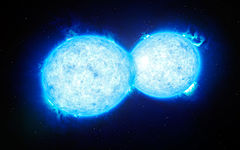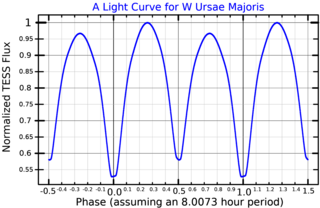
W Ursae Majoris is the variable star designation for a binary star system in the northern constellation of Ursa Major. It has an apparent visual magnitude of about 7.9, which is too faint to be seen with the naked eye. However, it can be viewed with a small telescope. Parallax measurements place it at a distance of roughly 169 light years (52 parsecs) from Earth.
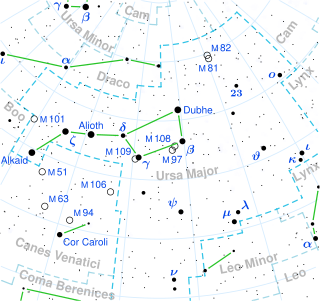
Dubhe, also called Alpha Ursae Majoris, Latinised from α Ursae Majoris, is, despite being designated "α" (alpha), the second-brightest object in the northern constellation of Ursa Major. This prominent asterism is known as the Big Dipper, the Plough, and the Great Bear. Alpha Ursae Majoris is the northern of the 'pointers', the second being Beta Ursae Majoris, or 'Merak' – this pair of stars point towards Polaris, the North Star.

Merak, also called Beta Ursae Majoris, is a star in the northern constellation of Ursa Major.
Megrez, also called Delta Ursae Majoris, is a star in the northern constellation of Ursa Major. With an apparent magnitude of +3.3, it is the dimmest of the seven stars in the Big Dipper asterism. Parallax measurements yield a distance estimate of 80.5 light-years from the Sun.

A W Ursae Majoris variable, also known as a low mass contact binary, is a type of eclipsing binary variable star. These stars are close binaries of spectral types F, G, or K that share a common envelope of material and are thus in contact with one another. They are termed contact binaries because the two stars touch and transfer mass and energy through the connecting neck, although astronomer Robert E. Wilson argues that the term "overcontact" is more appropriate.
Theta Ursae Majoris is a suspected spectroscopic binary star system in the northern circumpolar constellation of Ursa Major. It has an apparent visual magnitude of 3.17, placing it among the brighter members of this constellation. The distance to this star has been measured directly using the parallax method, yielding an estimated value of 43.96 light-years.

44 Boötis or i Boötis is a triple star system in the constellation Boötes. It is approximately 41.6 light years from Earth.

UW Canis Majoris is a star in the constellation Canis Major. It is classified as a Beta Lyrae eclipsing contact binary and given the variable star designation UW Canis Majoris. Its brightness varies from magnitude +4.84 to +5.33 with a period of 4.39 days. Bode had initially labelled it as Tau2 Canis Majoris, but this designation had been dropped by Gould and subsequent authors.
Gliese 412 is a pair of stars that share a common proper motion through space and are thought to form a binary star system. The pair have an angular separation of 31.4″ at a position angle of 126.1°. They are located 15.8 light-years distant from the Sun in the constellation Ursa Major. Both components are relatively dim red dwarf stars.

S Antliae is a W Ursae Majoris-type eclipsing binary star in Antlia.

Y Sextantis, abbreviated as Y Sex, is a variable star system in the equatorial constellation of Sextans. The system is invisible to the naked eye with a mean apparent visual magnitude of 9.88. It is located roughly at 1,300 light years from the Sun based on parallax.
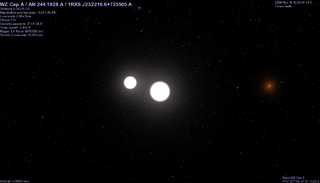
WZ Cephei is an eclipsing binary star of W Ursae Majoris-type in the constellation of Cepheus, located 880 light years away from the Sun. The stars orbit around a common orbital barycenter every 0.41744 days. Timing analyses have revealed the possible presence of a third low-mass stellar companion in a wide orbit.

RR Centauri is a variable star of apparent magnitude maximum +7.29. It is located in the constellation of Centaurus, approximately 320 light years distant from the solar system.

65 Ursae Majoris, abbreviated as 65 UMa, is a star system in the constellation of Ursa Major. With a combined apparent magnitude of about 6.5, it is at the limit of human eyesight and is just barely visible to the naked eye in ideal conditions. It is about 760 light years away from Earth.

V752 Centauri is multiple star system and variable star in the constellation of Centaurus. An eclipsing binary, its apparent magnitude has a maximum of 9.10, dimming to 9.66 during primary eclipse and 9.61 during secondary eclipse. Its variability was discovered by Howard Bond in 1970. From parallax measurements by the Gaia spacecraft, the system is located at a distance of 410 light-years from Earth.

TX Ursae Majoris is an eclipsing binary star system in the northern circumpolar constellation of Ursa Major. With a combined apparent visual magnitude of 6.97, the system is too faint to be readily viewed with the naked eye. The pair orbit each other with a period of 3.063 days in a circular orbit, with their orbital plane aligned close to the line of sight from the Earth. During the primary eclipse, the net brightness decreases by 1.74 magnitudes, while the secondary eclipse results in a drop of just 0.07 magnitude. TX UMa is located at a distance of approximately 780 light years from the Sun based on parallax measurements, but is drifting closer with a mean radial velocity of −13 km/s.
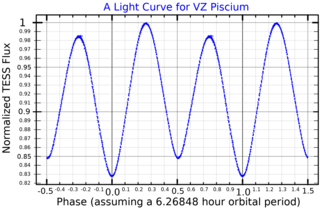
VZ Piscium is a binary star system in the equatorial constellation of Pisces. it is located at a distance of 178 light years from the Sun based on parallax measurements, and has an apparent visual magnitude of about 10.3. This is an eclipsing binary system that undergoes shallow eclipses; the brightness decreases to magnitude 10.45 during the primary eclipse, then to magnitude 10.43 with the secondary eclipse, although as a contact binary the brightness varies continuously with no period of constant maximum brightness. The system is drifting closer with a radial velocity of approximately −4 km/s, and has a net heliocentric velocity of 144.1 km/s.

VV Ursae Majoris is a binary star system in the northern circumpolar constellation of Ursa Major, abbreviated VV UMa. It is a variable star system with a brightness that cycles around an apparent visual magnitude of 10.19, making it too faint to be visible to the naked eye. The system is located at a distance of approximately 1,500 light years based on parallax measurements.

AW Ursae Majoris is a binary star system in the northern circumpolar constellation of Ursa Major, abbreviated AW UMa. It is an A-type W Ursae Majoris variable with an apparent visual magnitude of 6.83, which is near the lower limit of visibility to the naked eye. This is an eclipsing binary with the brightness dropping to magnitude 7.13 during the primary eclipse and to 7.08 with the secondary eclipse. Parallax measurements give a distance estimate of 221 light years from the Sun. It is drifting closer to the Sun with a radial velocity of approximately −17 km/s. The system has a high proper motion, traversing the celestial sphere at the rate of 0.216 arc second per annum.

BE Ursae Majoris is a binary star system in the northern circumpolar constellation of Ursa Major, abbreviated BE UMa. The two components are an unusual M-class dwarf star and a subdwarf O star, borderline white dwarf. It is classified as a detached Algol variable and ranges in brightness from an apparent visual magnitude of 14.8 down to 17.8. This is too faint to be visible to the naked eye. The distance to this system is approximately 4,600 light years based on parallax measurements.
